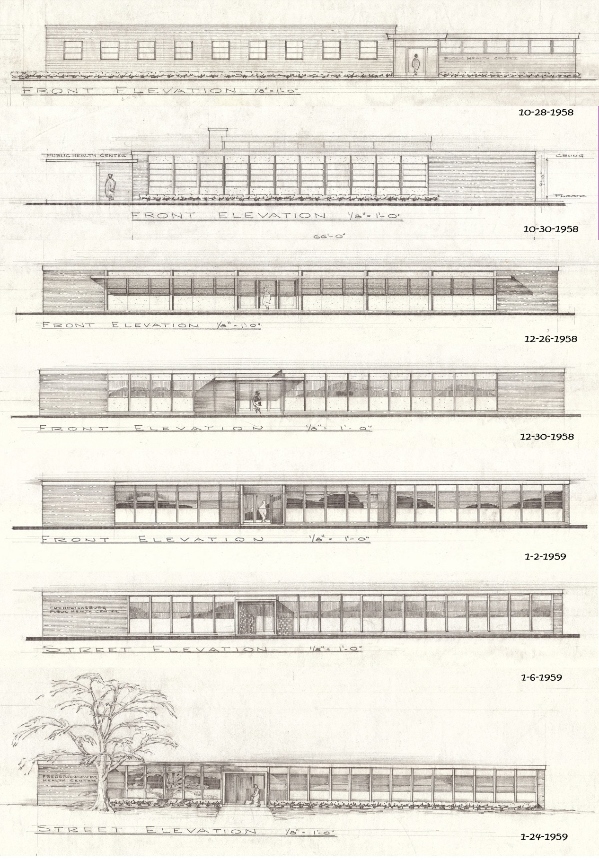
By ADELE UPHAUS
MANAGING EDITOR AND CORRESPONDENT
Plans for the Mary’s Landing townhouse project, which would be located across Fall Hill Avenue from the old Mary Washington Hospital, seek “open space credits” for preserving one mid-20th-century structure while calling for the demolition of two other early-to-mid-20th-century structures.
The building that would be preserved is also not actually part of the project development plan currently under review by city staff.
The development plan, which was submitted to the city in January by W.W. Webb and Associates, call for the demolition of the brick building at 435 Hunter Street and the 1930s bungalow at 2215 Fall Hill Avenue, while retaining the Medical Arts Building at 2301 Fall Hill.
The Medical Arts Building, completed in 1964 and constructed by local contractor Bernard Cline – who built many houses and office and commercial buildings around town in the 1950s and 60s – is identified as a “character structure” in the appendix to the city’s Unified Development Ordinance that outlines form-based codes for the T-4M and T-5M Creative Maker Districts, as well as T-5C Commercial Highway District. The Mary’s Landing project is zoned T-4M.
The Medical Arts Building is included in a list of buildings that relate to the primary period of significance for the T-4M Creative Maker District, “the mid-20th-century expansion of the highway system.”
The city’s form-based code appendix permits developments that preserve or “adaptively reuse” designated character structures to reduce the amount of open space required by “an amount no greater than the square footage of the footprint of the existing Character Structure.”
The plans for Mary’s Landing, which propose construction of 63 single family attached townhouse units, claim a 7,200-square-foot “open space character structure preservation reduction,” proposing 4,929 square feet of open space instead of the 11,063 square feet that would be required without the credits.
However, the Medical Arts Building is not proposed to be developed as part of the Mary’s Landing project, and city staff have asked the developer to address this issue.
In the city’s February 21 first review of the Mary’s Landing application, Marne Sherman, development administrator, wrote, “Since the Medical Arts Building property is used to count toward meeting the minimum open space requirements (Character Structure in the CM District) for the project, that property is part of the project and influences the overall project area and resulting open space requirements and frontage improvements. Please address throughout the plan and more clearly show the open space on Sheet 2 and in the overall plan.”
The two buildings that are scheduled for demolition, according to development plan, are older than the Medical Arts Building, but are not identified as character structures in the UDO appendix.
The building at 435 Hunter Street was completed in 1960 and currently houses the Rappahannock EMS Council, but it was originally built as the city’s Public Health Center. It was designed by local architect and historic preservationist J.J. Ballentine.
Ballentine, who died in 2007, was born in Baltimore and moved to Fredericksburg to practice architecture after serving in the U.S. Navy.
He was the first president of the Historic Fredericksburg Foundation, Inc. and according to a 2016 article about him by Michael Spencer, an assistant professor of historic preservation at the University of Mary Washington, he worked to preserve the city’s historic buildings by “implementing a revolving fund program that purchased properties beginning with the 500 block of Caroline Street with the intent to preserve them.”
In addition to the public health building, which displays the characteristics of mid-century modern design with its large windows and flat roof, according to Spencer, Ballentine also designed the building at 320-324 Caroline Street, now the home of Castiglia’s. Art and architecture critic Pauline King, chair of the UMW art department, described that 1956 building as an example of “excellent design,” with scale and materials that are in keeping with the rest of downtown Fredericksburg but still “unmistakably of the twentieth century,” according to a 1973 Free Lance-Star article.
Ballentine’s architectural drawings for the public health building are in HFFI’s collection and housed with UMW’s historic preservation department.
According to the UDO appendix, character structures for different historic districts were identified as part of the Small Area Plan adopted for that part of the city.
The plan for Area 6, where Mary’s Landing is located, was approved in February of 2019.
According to the form-based code appendix, which was approved in June of 2021, character structures are defined as “those structures contributing to the character of designated historic corridors or centers within the City.”
Kate Schwartz, the city’s senior historic resources planner, said character structures meet the City Code definition of “historic building,” which is any structure that is (a) listed individually on the National Register of Historic Places; (b) determined by the Secretary of Interior as contributing to the “historical significance of a National Register historic district;” (c) individually listed on the Virginia Landmarks Register; or (d) individually listed on a local inventory of historic places.
“The listed character structures [in the form-based code appendix] largely fall under D in the definition above as they were taken to the Architectural Review Board for review and added to our local inventory,” Schwartz wrote in an email to the Advance. “At the time that the Creative Maker Districts were being created and character structures identified, our survey efforts were largely focused on the Princess Anne Street and Fall Hill Avenue corridors rather than wholesale survey of the entire portion of the City. Identification of historic resources is an ongoing need and constantly evolving.”
The Mary’s Landing application has gone through one round of review by city staff, which “disapproved” the application, “pending correction” of a list of items. Chuck Johnston, director of the community planning and building department, said staff comments were provided to the developer on February 21 and that he expects the developer to respond to the comments “in two or three weeks.”
Johnston said there will be another review round and that it can take several review rounds for applications to be approved.



